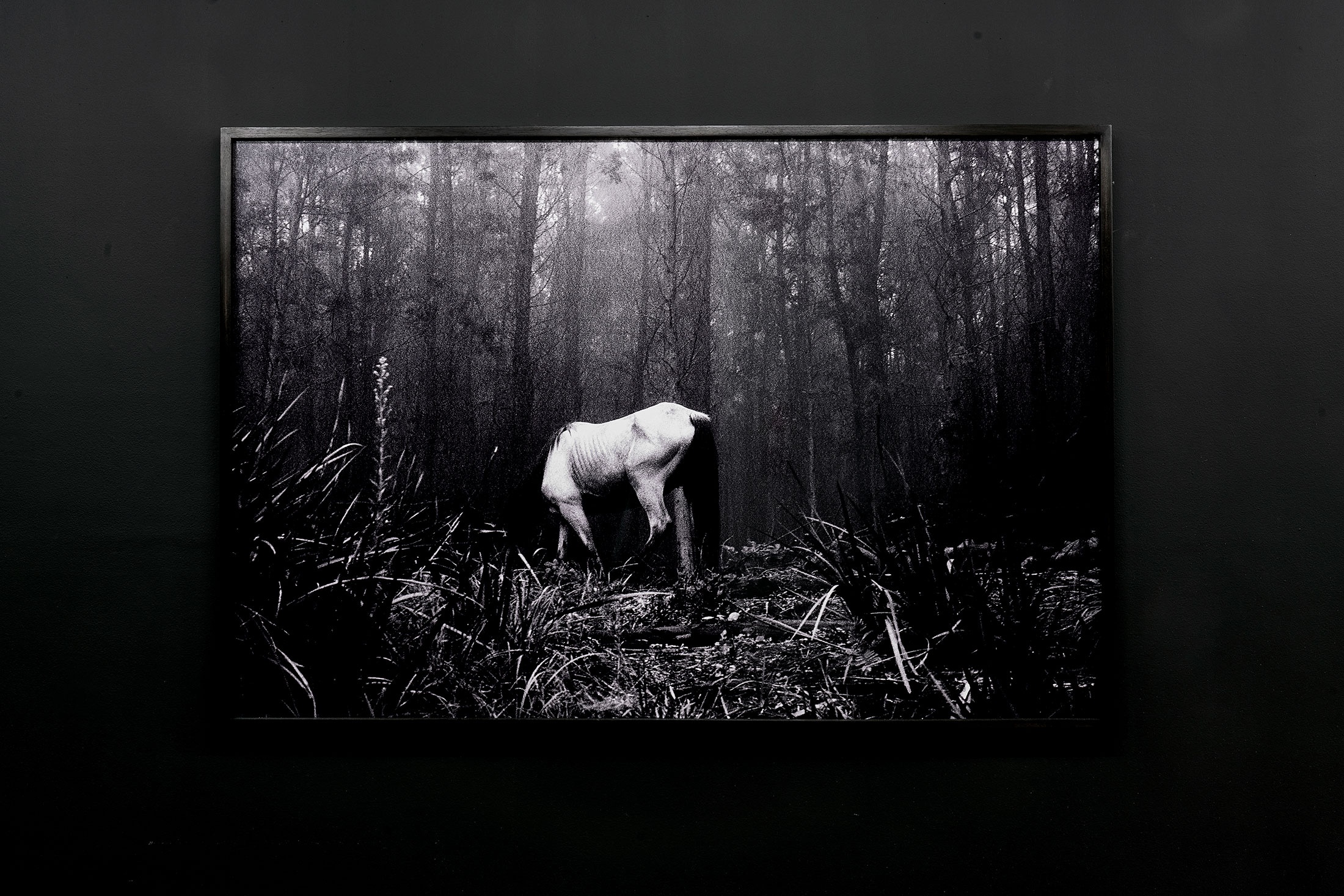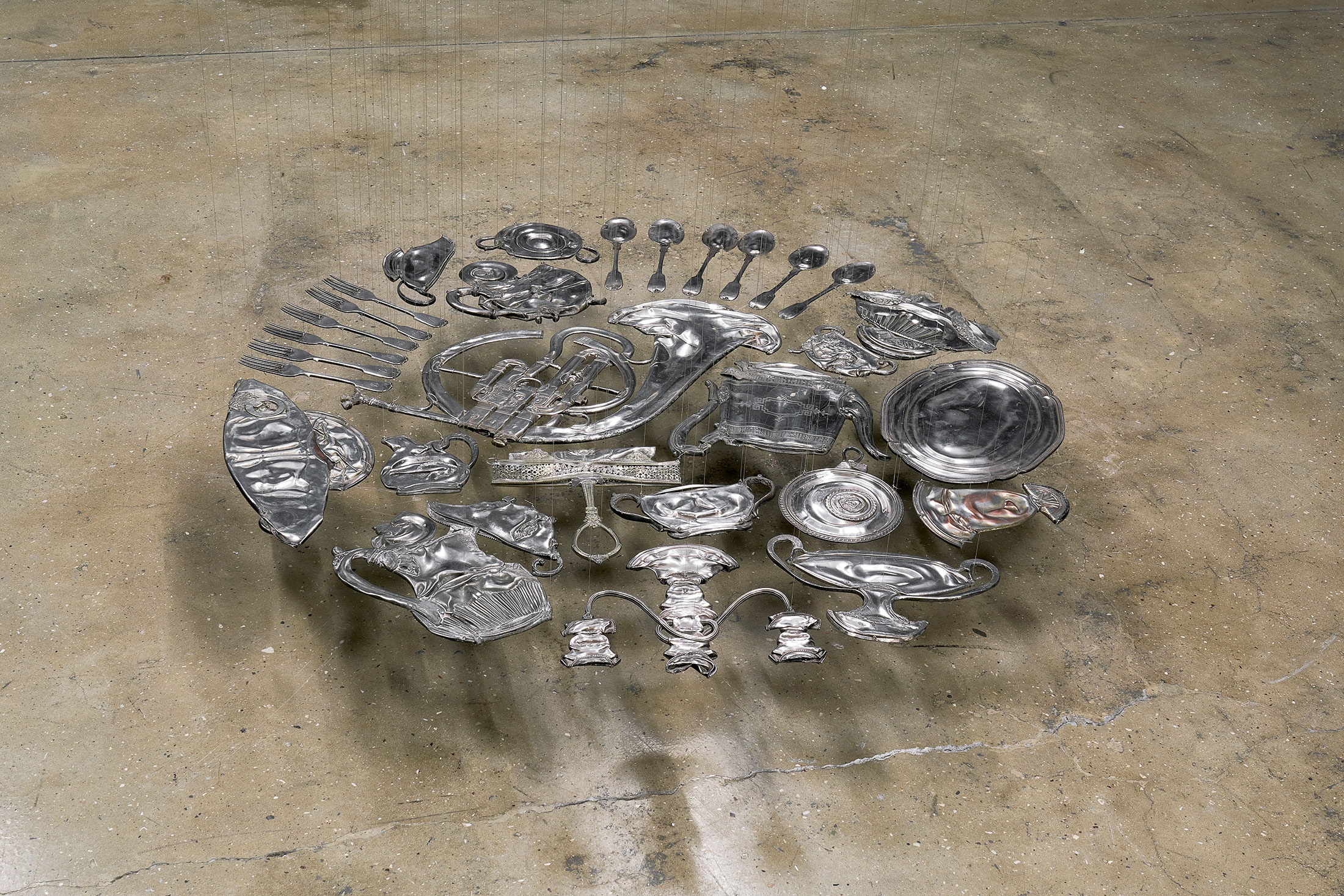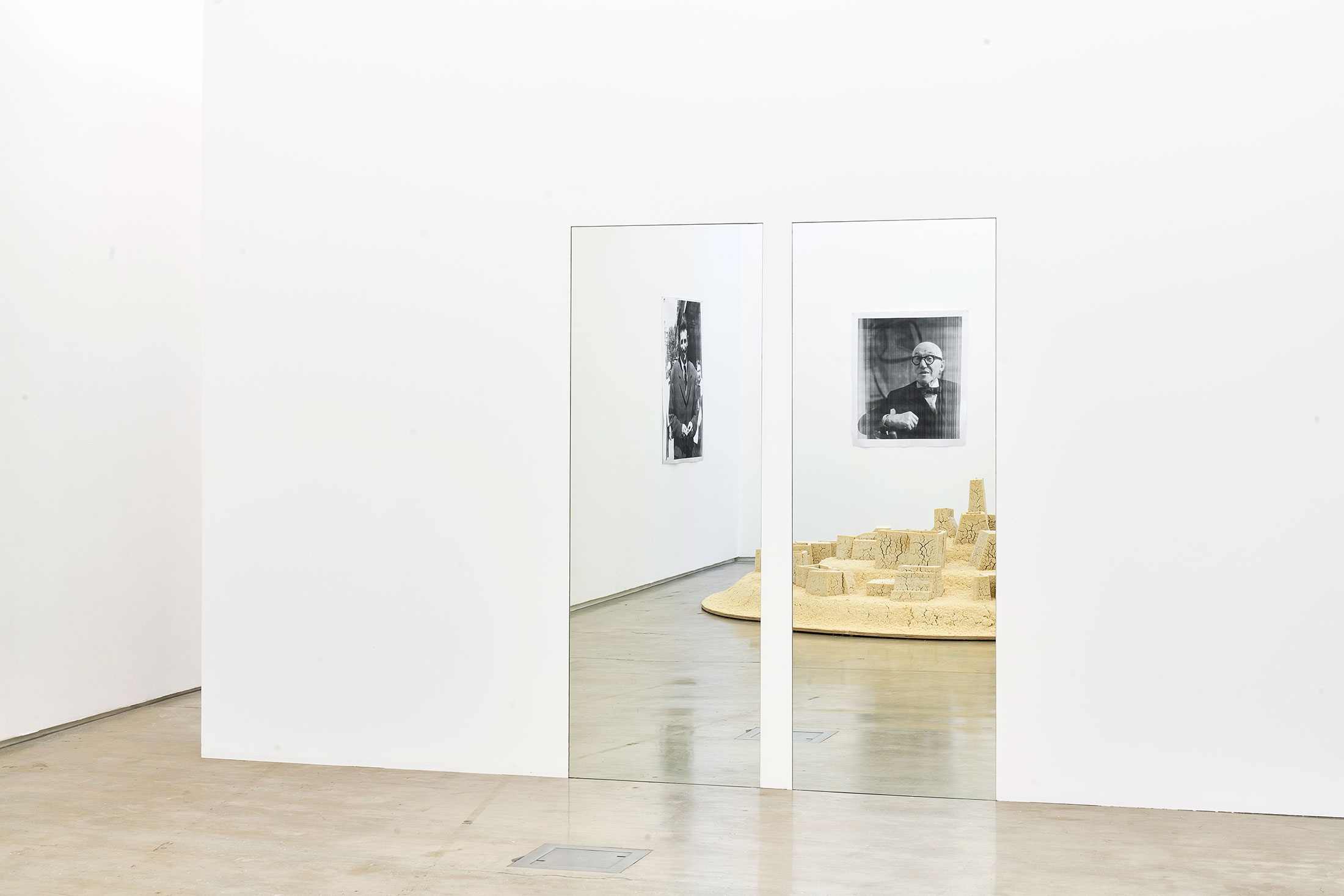J.G. The idea behind this show came from something you said, which in my memory was almost said in frustration one night over dinner. You said, “Why is it that we refer to the future as something in front of us, when in fact we can’t see the future. What we can see is the past. The future is behind us.”
You were saying that we effectively walk backwards into the future, which to my mind is a poetic idea and a sensible idea – an intersection of poetry and sense.
T.Y. Some symmetry breakings, like reading from left to right rather than right to left, happen for no apparent reason. In physics, they’re called ‘spontaneous symmetry breakings’. But this one has a certain angle to it – it isn’t arbitrary, because it affects how we view time.
And how you view time is a fundamental indicator of your cosmic view. Time is a very mysterious concept, but within the dominant Western paradigm, physics doesn’t view it as mysterious at all.
In fact, the Western metaphysical paradigm is preoccupied with killing time; turning time into space. There’s a dichotomy between space and time – space is studied through mathematics and time through computation. While time refers to an actual unfolding, space refers to the structural aspects of that unfolding. The success of physics depends on the fact that time lends itself to so much structural characterisation. This is the purpose of physics – to separate what’s unchanging from what’s changing.
J.G. Can you spend a moment talking about the relationship between time and space? In colloquial terms, that they are somehow interconnected is often referred to candidly. You said that time is an unfolding and that space is some kind of vessel.
T.Y. The word ‘spacetime’ was coined by Einstein. He came up with an object that allowed him to trivialise the effects of gravity by formulating it as a curvature. This is, however, a simplification.
Time has since been represented as a linear object, stretching from zero to infinity with all else indexed to it. It’s the primal index of physics. Time is what prevents things from co-happening – it gives order to life.
There was a famous public debate between Einstein and Henri Bergson in Paris. Bergson had two philosophical obsessions – the first was evolution and the second was time. While Einstein spatialised time completely, Bergson wanted to do the opposite and temporalise space by viewing space as something like ‘dead time’. Bergson lost the debate, and thereby humanities lost against science on probably the most important philosophical topic of all.
Put in a different language, what Bergson was trying to articulate was the structure of ‘now’, a notion that lies at the heart of Eastern metaphysics.
What’s already happened – the collection of past ‘nows’ – do lend themselves to a certain characterisation. But ‘now’, itself, keeps generating novelty that can never be completely anticipated.
An action unfolding, at the moment of unfolding, is deeply connected to the notion of consciousness. In fact, the simplest word for ‘consciousness’ in Eastern metaphysics is ‘now’. So this view of time is very subjective. Of course, science and Western metaphysics don’t like what’s subjective – they want to objectify the world, codify the world, put it in mathematical language and place it on a shelf.
What Bergson argued for, against Einstein, was a defence of Eastern metaphysics in disguise, formulated in the language of the new century.
J.G. Within that, you pointed earlier to time articulated simply as a line. In either of these cases, do they offer alternative pictorial, graphic or other models for how to imagine time?
T.Y. Western metaphysics pictures time as a simple line, which in turn is merged into space to become ‘spacetime’, which can curve like space itself. It’s visualisable, but only from the so-called God point of view; from outside the universe.
But how can you be outside of time? And is there a corresponding graphical representation of time in Eastern metaphysics? I think categorically there cannot be, because once a phenomenon is put into a linguistic form, it becomes static and no longer truly represents what was originally meant. Time, in the Eastern view, is hard to articulate because it is fundamentally inarticulable.
Of course, explicit articulation is a function of the analytical side of the brain, as opposed to the intuitive side. And intuition is why art exists. If things were simple and homogeneous, we wouldn’t need art.
The best visual representation of time in the Eastern program would look like a flow – of water, perhaps, but a ‘structured’ kind of water. I personally view it as a ‘dark’ flow that is informatic in nature, as opposed to being merely energetic.
Energy is the currency of mathematical models, and information is the currency of computational models. Due to the dichotomy between energy and information, we tend to think of fluids as solely energetic objects.
But time as a flow constantly evolves and evades complete spatialisation, always remaining partially in the dark, in the domain of the unknown.
J.G. What comes with trying to assemble a picture or language to describe a phenomenon in your mind is a capacity to talk and think collectively.
T.Y. Religious leaders had a similar problem while trying to articulate a deep concept in a way that was understandable. I think the best analogies come from the world of Sufism, a mystical branch of Islam. Sufism has a particular obsession with visual metaphors. They have several well-known metaphors, one being water. They also say that stark reality is like a mirror. When you look at a mirror, you see yourself. But, there’s an illusion. The mirror is actually behind the reflection, and it’s in the dark. You never see the actual mirror. The true object doesn’t reveal itself to you – it remains unknown, in the back.
Think of yourself as a mirror. What remains at the back, in the dark part? Your mind, your thoughts? What appears to others in the front of the glass? Your body? Which is more real?
J.G. In an exhibition, for example, the artworks would be nodes and the dynamics between them, the flow. One of the pieces in this exhibition is called Prayer by James Webb – a project that the artist started 22 years ago, recording the prayers of as many denominations or faith groups that he could find in a particular city. There’s a red carpet with twelve speakers on it, each one playing a different prayer. You either hear a cacophony of prayers or, if you sit listening, one individual song.
Another work, just two mirrors, is by a now-deceased artist named Felix Gonzalez-Torres. The mirrors stand alongside one another, representative of himself, his lover, the infinity of their love, the affinity of their love.
T.Y. I don’t know what those artists were thinking, but you can always re-conceptualise artworks after they’ve been created. Creation is an unconscious process. I don’t think artists always know what they’re doing, which is why interpretation is necessary.
J.G. I think it’s worth noting that interpretation occurs not only through text or in overt communication, but as a function of proximity to other things. The flow that you’ve been referring to is in some form similar to how those philosophical inquiries occurred when there was an incapacity to render them. What was experienced was a relational event. To some extent, the dynamics between things are also an expression of what is happening.
T.Y. These artworks won’t communicate with each other by themselves, someone needs to mobilise their communication flow, which is why we have curators. It is always life itself which mobilises the flow.
This is much easier to visualise in the world of science. If we were to replace artworks with scientific articles and the links between them with citations, a network with articles as nodes and citations as links would be created, establishing communication between what are otherwise static objects.
Sometimes I open a book and start from the reverse. By looking at the biography, I can tell what the thesis is. I can feel what this author is about to say because I can see where the substantial meat of the text comes from. We are all making very small contributions to the general accumulation of culture. We are connecting things and adding small bits of our own. The Western world over-emphasises agency and individualism, and so we view ourselves as masters of the universe. But history doesn’t work like this, art doesn’t work like this, science doesn’t work like this because they are collective phenomena. We are facilitating a flow. We are like nodes in a network. Ideas flow through us, through articles.
Ideas, words, sentences, and metaphors in books want to jump out of the text, become mobile and dynamic. We try to counteract this, freeze ideas and attach names to them. But the truth of the matter is that the essential core of any work does not belong to the artist nor the author, and whatever sliver of originality is produced sooner or later becomes anonymous, if it is any good. We can only protect ideas for a limited amount of time. We think of a library as representative of culture. I think of it as a skeletal relic. The live parts, the good ideas, have already been extracted and are circulating among us.
The time we can see is the ‘dead’ time, the library etc. This is what Bergson wanted to emphasise too.
J.G. If one’s inclination is to make a picture to understand something, then one needs, in the same minute, to resist that image, to allow it to evaporate and let it keep acknowledging its natural limits. Otherwise, one would stick too tightly to analogy.
And analogy is, at best, a weak attempt at representing an inarticulable, potentially unknowable condition.
There is a dynamic between using the mind and resisting the mind, a proportional dynamic that needs to be put in place.
If badly proportioned, one sticks too closely to a limited pictorial framework.
Can we go through the death analogy again? In your picture of a library of books, the citations, the relations or learnings that emerge from the reading of them are the life force. They move, they catalyse. But what is the book itself?
T.Y. The book is a mediator. It’s a node in a slow network.
J.G. So it’s not deceased because it has the capacity to do work.
T.Y. No, it’s nothing in isolation. It is animated by us.
J.G. Maybe it is as dead as a stone is dead?
T.Y. I view it as a sponge that is squeezed as it’s animated.
J.G. Time, as you pointed out earlier, seems still to be orientated around space. It seems to be situated in a conceptual model of space.
T.Y. That spatialisation paradigm has reached its limit, and time is returning, we can’t get rid of it.
J.G. This may be an over-simplification. But if the future is an unseeable domain, then it’s arguably unseeable by everyone, which means you’re no longer arguing over a differentiation of view.
If there’s a condition that agrees to the fact that that future is unseeable and that we all sit inside this unseeable future, we move closer to the proposition of oneness.
We limit the noise of competing ideas.
T.Y. It’s a revelationary process. We are trying to decipher this revelation together, but it requires courage in the sense that we, people, know we’re walking into darkness.
J.G. The alternative is an acknowledgement that you don’t see anything, and that nothing is lit because it’s behind you. I’m reiterating this in the spirit of feeling a plausible, generative condition off the back of your quote. It’s not only an optical orientation, but a philosophical orientation.
T.Y. But your conclusion is that, at an instinctive level, both views are wrong – that the future is neither behind us, nor in front of us.
Einstein said that God is subtle but not malicious, because he, himself, ventured into one of the greatest darknesses in our intellectual history and emerged with light.
Newton spent ten to fifteen years in darkness too, which no one would do today. What motivated both Newton and Einstein was religion. Newton was more of a theologian than he was a physicist. His belief in Western metaphysics, in the unmoving truth behind all this flux, motivated him not to give up for all those years. Einstein was not a believer in Christianity, but he was a very spiritual person. He believed that God was kind and framed this as a motivation for the young scientists of the future. Because when you venture into the darkness, you need to know at least that success is a possibility, that an object in the darkness is actually waiting for you to discover it.
Why is God kind? Life doesn’t seem to be a coincidence or a fluke. It seems that we are here to play a potentially solvable, yet unsolved game.
I studied mathematics at Harvard University, and in retrospect, I feel like these places are the new temples of the Western world. Mathematicians are looking for clues to solve the cosmic riddle. They are doing priestly work, at the frontlines, at the cutting edge of the unknown.
Someone said that the future is already here, but that it’s unevenly distributed.
We are living in the year 2022, but according to what metric? Because the earth revolved around the sun a certain number of times?
J.G. I hadn’t considered that time is subjective, distributed unevenly across all participants. As opposed to a situation in which there is a barrier that we’re either in front of or behind, there are coexisting conditions of time.
T.Y. The future is not behind or in front of us, it is both.




